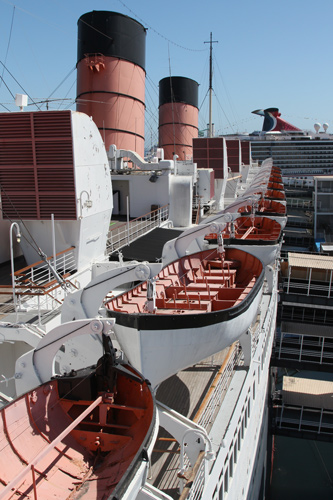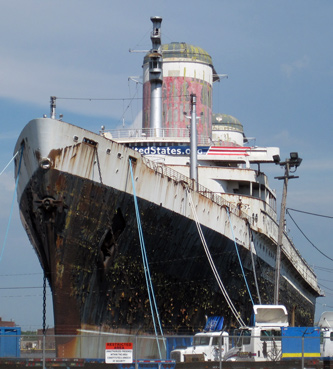In the modern era of aviation, crossing an ocean takes a matter of hours (at a surprisingly affordable price). Except certain events like the introduction of the jumbo-jet 747 or the supersonic Concorde on the route, this journey no longer captivates the imaginations of the general public.
A century ago, when aviation was still a young technology, record-setting crossings by ocean liners were front page news: An unofficial competition known as the Blue Riband (or less commonly, Blue Ribbon). According to Arnold Kludas in his book Record Breakers of the North Atlantic, “The term Blue Riband was borrowed from the world of horse racing, and it was around 1890 when journalists first applied it to record voyages across the North Atlantic, although it did not come into general use until the start of the twentieth century.”

Blue Riband winners include some of the most legendary ships every to ply the oceans, with names like Lusitania, Normandie, and Queen Mary. Though fast and luxurious, the years have not been kind to those ships that claimed the figurative ribbon. Most were scrapped. Some, like the Lusitania and Rex, were sunk during the World Wars.
Only two Blue Riband winners remain afloat, the RMS Queen Mary and SS United States. The former—permanently docked as a hotel and museum ship in Long Beach, California—is secure. The future of the latter—docked in Philadelphia, Pennsylvania—is in doubt. The Queen Mary seized the Blue Riband from the Normandie in 1936. After the Normandie reclaimed the title in 1937, the Queen Mary edged out its rival with a new record in 1938. During its maiden voyage in 1952, the United States captured the Blue Riband, crossing westbound at average speed of 34.5 knots (an impressive margin of 3.5 knots over the Queen Mary’s 1938 record).
Ironically, though the competition was invented by journalists, the rules were unwritten ones. The vessel in question had to be a passenger liner (and transporting passengers during the voyage). According to Kludas, the following conditions had to be met by the vessel:
“First, she had to cross the Atlantic at a higher average speed than the current holder of the Blue Riband. Second, the record crossing had to take place in the westbound direction, i.e. form Europe to America.”
The average speed measurements were strictly open ocean running, not port to port. A liner traveling from Southampton to New York might have had its speed measured from Bishop Rock Lighthouse to Ambrose Lightship (as the last five records were). After all, different ships would be departing from different ports in Europe and the distances traveled would vary.

It would not have been fair to, for example, compare the travel times of a German liner departing from Bremerhaven, an Italian liner departing Genoa, and a British liner departing from a port further west like Queenstown strictly by time dock to dock. Similarly, limitations on entering the congested port areas would not be a fair test of the ship’s capabilities. Maneuvering speeds were low and a ship sometimes had to wait for a slot to become available. For instance, the SS United States was so far ahead of schedule during its record-setting round trip that it had to anchor off both Le Havre and New York for the night before entering port!
Kludas also explains that the east to west requirement was because, “That is the more difficult course, as it runs counter to the Gulf Stream and the prevailing westerly winds.”
As an unofficial competition, there never was a physical Blue Riband awarded to any ship, although at least two, the Italian liner Rex and the aforementioned United States, celebrated their accomplishment by flying a blue pennant.
The Hales Trophy is usually discussed at the same time as the Blue Riband. This award’s requirements have evolved over the years, but key differences are that the Hales Trophy-winning vessel can travel across the Atlantic Ocean in either direction and does not necessarily have to carry passengers while doing so.
Thus, while three ocean catamarans have claimed the Hales Trophy for eastbound crossings without passengers, the SS United States has retained the Blue Riband since 1952. It is likely to retain the title permanently given that modern passenger ships are typically built for comfort rather than speed; they simply cannot compete with aircraft in that realm.

Let’s do all we can to save this Great Ship from the Wrecking Ball……Ian Robertson. http://Www.oceanlinerrow.com. my website
LikeLike